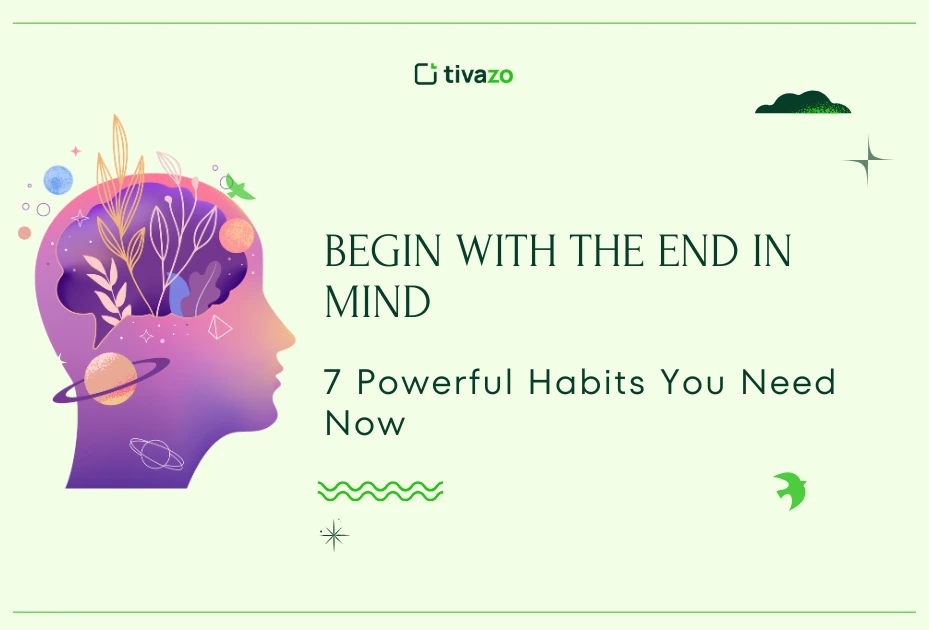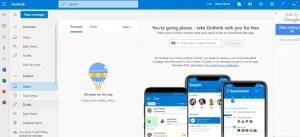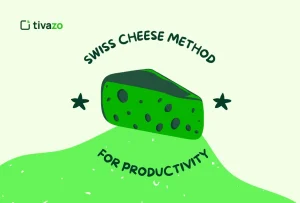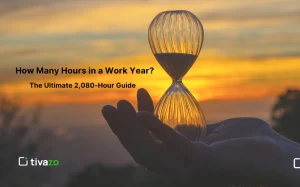Do you ever feel that you are incredibly busy but that you are not achieving anything? You’re not alone. In a society filled with notifications, dopamine loops , and the expectation to hustle, it can be so easy to lose your way. There’s a reason why Habit 2 of Stephen Covey’s The 7 Habits of Highly Effective People endures: Begin with the End in Mind.
But this principle is not just feel-good hoopla. It is a manifesto for purposeful living. It asks us what success means to us, and then to reverse-engineer our lives in a way that makes it possible. We’ll dig into the psychology behind it in this piece.
We’ll introduce seven modern habits that help you align your daily life with your long-term goals, perfect for creatives, people with ADHD, Gen Z professionals, and adults who seek purpose and are overwhelmed.
keypoints
- Visualize your future self to guide daily decisions.
- Practice the 7 habits that promote purposeful living.
- Create an environment that boosts focus and goals.
- Break goals into clear, manageable steps.
- Stay flexible—let your vision guide, not limit you.
The Psychology Behind “Begin with the End in Mind”
Our brains are wired to crave short-term wins. “When the choice is made, now or later. We are biased toward the present,” psychologists write, in something of an understatement, in a recent paper on this bias, which they call “present bias.” But when we picture our future selves in vivid terms, brain scans show that our prefrontal cortex, the part of the brain responsible for planning and logic, lights up.
Bottom line: When you emotionally connect with your future self, you make better choices in the present. Which is what makes “Begin with the End in Mind” a ground-based strategy, not just a feel-good notion.
7 Powerful Habits That Embody “Begin with the End in Mind”

1. Be Proactive
Being responsible for your life and actions. Instead of reacting to or worrying about conditions over which they have little or no control, proactive people focus on the things they can do something about. That mentality is empowering, and it gives you control over writing your own story. It’s the first step if you want to begin with the end in mind and live on your terms. For example, instead of “I can’t do this,” try emphasizing “I choose to do this.”
2. Begin with the End in Mind
This habit is really about having a vision for the future and letting that guide your decisions each day. When you know your North Star, you can prioritize and avoid distraction. Crafting a personal mission statement can help bring your most well-founded choices into sharp focus.
3. Put First Things First
Learning to prioritize your time towards what’s important is a skill that will help you be more productive and increase your self-management. Leverage tools like Covey’s Time Management Matrix to spend more time on activities that make you grow and are in sync with your goals (Quadrant II). Make these priorities guideposts for your week, rather than simply reacting to the day-to-day fires. This habit works best when you begin with the end in mind
4. Think Win–Win
This practice is fundamentally about seeking solutions that are for the greater good rather than wanting to “win” and compete with others. An abundance mindset, like that there’s enough success to go around and resources for everyone, will help you build trust and strong relationships. When conflict arises, ask what success looks like for both parties to develop mutual solutions. Collaborating this way means we are starting to begin with the end in mind, not just solving the problem.
5. Seek First to Understand, Then to Be Understood
Good communication begins with actually listening and not just preparing your response. Reflecting back to others what you hear before you share your thoughts means you get to be sure you are hearing others accurately, and it minimises the chances of conflict. This aligns beautifully with Habit 2: Begin with the end in mind.
6. Synergize
Synergy: The whole is greater than the sum of its parts. Comfortable with diversity of thought and respectful disagreement fosters creativity and innovation. Having teams where everyone brings unique strengths to the table leads to stronger results.
7. Sharpen the Saw
Your world whispers, and it impacts your behavior. James Clear refers to it as the “invisible hand” — it’s guiding your behaviors without you even realizing it. If you are so inclined to embrace long-term thinking, you must make a conscious effort to design the spaces around you that reinforce clarity, identity, and focus. This is part of what it means to begin with the end in mind, shaping your surroundings to support the future you want.
The Role of Environment in Long-Term Thinking
An organized mind is happiest in an organized space. When the space around you is neat, your brain doesn’t have to work overtime to wade through visual clutter. Maintaining a clean desk and getting rid of things that break your line of sight and potentially blur tools, like out-of-sight noise-cancelling headphones or website blockers, can help with concentration and produce easy entry into deep work.
1. Focus Design: Create a Distraction-Free Workspace
An organized mind is happiest in an organized space. When the space around you is tidy, your brain doesn’t have to work overtime to wade through visual clutter. Maintaining a clean desk and getting rid of things that break your line of sight and potentially blur tools, like out-of-sight noise-cancelling headphones or website blockers, can help with concentration and produce easy entry into deep work. This kind of setup helps you to begin with the End in Mind every time you sit down to work.
2. Identity Design: Surround Yourself with Goal Cues
Your surroundings should reflect the person you’re working to become. Placing vision boards, inspirational quotes, and meaningful objects in your space serves as a daily reminder of your goals and values. This visual reinforcement strengthens your identity and makes it easier to act in ways that align with your long-term vision.
3. Digital Minimalism: Turn Your Phone into a Tool
Digital distractions are one of the greatest obstacles to long-term focus. And by making your phone a tool, not a toy, you also take back control over your attention. Deleting social media apps, turning off nonessential notifications, and storing only essential apps on your home screen are some ways to use your technology more mindfully and less habitually.
These kinds of works help you to begin with the end in mind every time you sit down to work.
Determine Sensible and Achievable Targets for Success
Having a clear purpose or an aim helps you make positive progress in any aspect of life. Whether you’re trying to get better at something or establish a new habit, when you break your goal into small parts, it’s easier to accomplish. Exactly what it means to begin with the end in mind, to act today, and tomorrow with the mind.
For example, if you want to improve your public speaking:
- Determine exactly what you want to accomplish — specifically, delivering a 5-minute speech with confidence.
- Monitor your progress by practicing once a week and recording yourself to see your progress.
- Ensure that your target is realistic by targeting small groups first and then expanding to the larger audience.
- Link this goal to a bigger cause, like career development or self-esteem.
- Give yourself a deadline, like training for a speech you’re giving in three months from now.
When your goals are clear and action-oriented like this, you get to walk a clearer path, and you are more likely to stay motivated and to succeed.
The Vision Cascade: From Life Purpose to Daily Action
You have to see both the forest (vision) and the trees (daily to-dos).

- Step 1: Identify your Life Purpose (in other words, the big picture).
- Step 2: Set 3-year goals.
- Step 3: Chunk those down into themed, quarterly projects.
- Step 4: Design daily actions.
Sketch this out visually with mind maps, Miro, or even on a whiteboard. These steps help you to begin with the end in mind, from a big vision down to small steps.
Time as a Reflection of Purpose
Actions not only tell us the time, but they also serve as receipts for what’s real. Instead of time as currency, consider time as a mirror reflecting to you your values.
- Covey’s Time Matrix: Concentrate on Quadrant II tasks — those which are important but not urgent, such as learning, planning, and building relationships. These things have a degree of a longer life and stretch out for some time.
- Planning tip: A Weekly Preview (such as Sunday night) that is repeated each week to connect your schedule and your deeper goals before the insanity of the week starts.
- Practical example: 30 minutes of mindless scrolling can become 30 minutes of reading a book or an online course that will help you achieve your long-term vision.
Rethinking Success: Internal Metrics Over External Validation
Success for you doesn’t mean more likes and followers. What you need is greater meaning and purpose in your job. Outside consent tends to go away, but inside satisfaction is forever.
- Trap to avoid: Chasing money, titles, or social status is the most common trap. It will keep you focused on other people’s opinions instead of your growth. This chase will leave you feeling empty despite the achievements you get in life.
- Instead, define your success metrics with fulfillment, impact, and joy. These internal KPIs will reflect what matters to you. It will help you stay aligned with your true purpose.
- Creator tip: Celebrate “invisible wins” such as consistency and courage.
Myth-Busting: “Begin with the End in Mind” Isn’t Inflexible
A lot of people believe you need to have a perfect plan, good to go, before you even start. That’s a myth. What you need, what you long for, is clarity of purpose — a master goal that will help you choose where you want to be.
Life is unpredictable and always changing continuously, and your vision will act like a GPS. It keeps you moving to the desired destination even when you are forced to change the route along the way. But you don’t have to know every step perfectly, just where you want to go.
This flexible approach allows us humans to roll with the punches when things don’t go as expected, and still slog ahead with determination. So begin with clarity, not rigidity, and let your plan expand as you do.
- Myth: You need an amazing plan to begin.
- Truth: You want direction, not hard info.
Life is agile. The vision informs meaning even when plans pivot. Think of it like GPS — you can always take another route, but the end point is the same.
Start Where You Are: Applying the Habit at Any Life Stage
- Students: Choose classes or majors aligned with your future impact.
- Professionals: Negotiate roles or projects that move you closer to your vision.
- Entrepreneurs: Build backward from a legacy or exit vision.
- Parents: Design family values and rituals with intention.
Begin with the End in Mind in the Age of AI and Attention Overload
In 2025, we don’t need to find information — we need to filter out the noise and distractions that draw us in every direction possible. There are so many possibilities that it’s hard to keep your eye on the prize.
- AI tip: AI tools, like ChatGPT, can assist you by organizing ideas, and a Genealogical help system can accelerate your research, but they should be supporting your deep thinking, not trying to do it for you. Otherwise, use them as help, not as decision makers.
- Protect your attention: be selective of what you watch. Establish parameters with filters, notifications, and regular digital detoxes to keep your brain free.
- Ask often: “Is this helping me grow into the person I want to be?” And this question also prevents you from getting blown around all the time by whatever’s distracting you at the moment.
Micro vs. Macro Vision: Why You Need Both
Differences between Micro and Macro Vision are:

Conclusion
In today’s world of distractions, urgent matters, and external expectations, starting with the end in mind is far more than a time management tip — it’s a survival skill for a meaningful life. It jolts us out of immediacy and says, wait, let’s do a little time travel for a second: Where am I going? and Why does it matter? Because when you live with vision, you move out of a reactive posture and into one of creation. That’s the gift of the habit to begin with the end in mind — it reclaims your future from the noise of now.
Whatever your role — student, creator, parent, professional — your daily actions become more meaningful and focused when you join them in service of your long-term purpose. Here, the issue is not that there is too high a bar for a perfect plan to clear. It’s about having a compass. And that compass — your values, your vision, your future self — is what helps you stay grounded as the world accelerates.
Start where you are. Stay flexible. And don’t forget: Success is not only getting to wherever you are going — it is becoming the sort of person who was always meant to get there.
FAQs
2. How do you teach Habit 2 Begin with the End in Mind?
Start by helping others define their core values, write a personal mission statement, and set long-term goals that guide daily actions.
What are the main points of Habit 2?
Main Points of Habit 2 are:
Define your personal vision and purpose
Use that vision to guide decisions
Align daily tasks with long-term goals
Why is Habit 2 essential for productivity?
It gives your actions direction, helping you prioritize what truly matters instead of reacting to distractions or urgency.
Can you apply Habit 2 without having everything figured out?
Yes — you don’t need a perfect plan, just clarity of purpose. Your vision can evolve as you grow.




